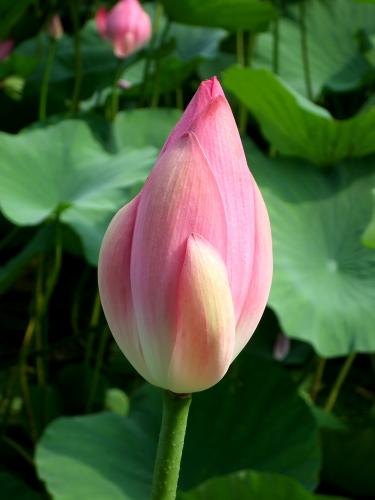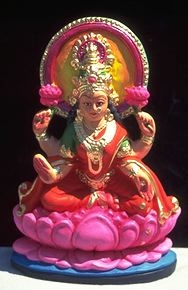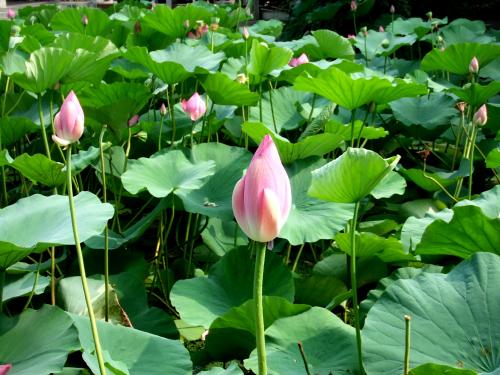【08.07.24 chinaexpat】The Wonder Of China’s Beautiful Water Lotus
【来源】chinaexpat
【链接】http://www.chinaexpat.com/blog/cde/2008/07/23/wonder-china-s-beautiful-water-lotus.html
【标题】The Wonder Of China’s Beautiful Water Lotus
【正文】

It's July, and everywhere in China, the Water Lotus is now in bloom. Parks across the country have suddenly bloomed fireworks that looked like lotuses, with outer petals fading from white to pink and central rings of rose deepening to red. Always in lakes and ponds, the flower of July for China blooms in water. What could be more cool and refreshing during the hot days of July than contemplating the water lily?
From the earliest Indian collection of Buddhist sutras, from the reign of Ahyu, comes this description of the beginning of the world: "Between the mountains there were many rivers, flowing in all directions along 100 different routes, moving slowly downhill, without waves. The rivers were shallow and their banks weren't steep, making them easy to ford. The water in them was clean and pure, and flowers floated on the surface in abundance. The currents were full of them..." According to this passage, the lotus was the first flower appearing in a world of water.
Although there is a botanical distinction, the lotus and water lily are often used interchangeably in folklore and mythology. Generally lotus refers to the water lily of India or the plant depicted in sacred art and stories, while the water lily is more often used by naturalists. As an example of the confusion, the World Book actually has two entries, one for the lotus, one for the water lily, both clearly referring to the same plant and neither referring to the other entry.
The lotus of India belongs to the Nelumbo genus (Nelumbo is the Sinhalese name for the plant). It has large flowers and leaves that sometimes grow up above the water. The plant's thorny stalk discourages fish from nibbling on it. The upper cupule or fleshy capsule of the lotus dries out at maturity and separates from the plant. Floating about, it scatters seed from the many perforated holes in its surface.
In Asia, there is only one species of lotus with red and white blooms. Yet early Buddhist scriptures, referring to the seven precious lotuses, mention blue and yellow flowers. The water lily, native to Egypt, has blue flowers but the yellow-flowered water lily is native to North America. This mystery may be addressed in this Buddhist sutra: "The lotuses of heaven can change according to people's wishes, flowering when needed. In this way they bring joy to the hearts of all. There is no need to declare one false and the other real. Both are called the wondrous lotus flower."
The Water Lotus has long been considered a sacred plant, with many sayings attributed to her subtle charms:
When the white lotus descends to this world, it changes everyone's life for the better.
- Chant from the White Lotus Sect, Ming dynasty
The oldest representation of the lotus was made centuries before anyone ever wrote about it: a statue unearthed at Mohenjo-Daro showing a wide-hipped goddess, lifting her breasts with her hands and wearing lotus blossoms in her hair. The Hindu goddess Laxmi, is also called Padma, Kamia and Kamalasana, all names for the lotus. She emerged from a lotus which sprang from Vishnu's forehead (an improvement on Athena's method of birth, I think). Vishnu himself is pictured holding a conch, a wheel, a mace and a lotus in his four hands.
The earliest written reference to the goddess in a supplement of the Rig-Veda describes her as born of the lotus, standing on the lotus, garlanded with lotuses. She is the hue of the lotus, lotus-eyed, lotus-thighed. She is often depicted flanked by white elephants who pour water from their trunks over her and the lotus she holds. Supposedly elephants love to eat the stems of lotuses.

In India, the Lotus also represents birth. Vishnu puts forth from his body a single giant navel on which Brahma, the lotus-born Creator is seated. This lotus has 1,000 golden petals from which mountains rise and waters flow. Buddhism borrowed the lotus pedestal from Brahma. The Buddha is often depicted sitting on a lotus or holding a lotus. Yoga students and meditators sit in lotus position. Legend says that when the Buddha was born, he walked seven steps in ten directions and with each step a lotus flower appeared. Look closely at the soles of his feet when you see a statue of Buddha - you may see the imprint of the lotus.
Buddhist periods are initiated by the appearance of a lotus, which indicates the location of the sacred tree of the Buddha. If there are no blossoms, no Buddha will appear. At the beginning of the current era, the Bhadrakalpa, there were 1,000 blossoms, signifying the birth of 1,000 Buddhas. The Buddhist sutras say that the lotus has four virtues: scent, purity, softness and loveliness. Yet as Chang Chin-ju notes, many other flowers are soft, clean and fragrant. The lotus was singled out because Chinese botanists once believed that it flowered and bore fruit at the same time, thus symbolizing the ability to transcend the limitations of time.
In China, even before Buddhism arrived bringing its special devotion to the lotus, the lotus was honored as the plant of summer. One of the eight immortals holds a lotus, the "flower of open-heartedness" or a lotus-pod wand. It was an emblem of purity, fruitfulness (because of its many seeds) and creative power.

The Lotus Sect of Chinese Buddhism believes that people can be rewarded for virtuous acts by leaving the cycle of reincarnation and going to dwell in the Western Heaven. This paradise contains the Seven Treasure Pond which brims over with the Water of Eight Deeds and Virtues. The bottom of the lake is covered with gold dust and the lotuses are as big as carriage wheels. The blue flowers give off a blue light, the red a red light, the yellow a yellow light and the white flowers a marvelous fragrance. The different colors have different meanings. White represents purity, blue goodness and red enlightenment.
The Sacred Lake of Lotuses is often depicted in Temple Courtyards. Each soul has a lotus on this lake which will open to receive them after death and where they will wait until the time of its opening. The flowers thrive or droop according to the piety of the individual on earth; for the devout they open immediately when he dies, admitting the soul at once to the divine presence. In China, the envelopes given to the family at a funeral are impressed with the outline of a lotus. And in rural areas, people still burn incense to the Spirit of the Lotus. In Chinese Buddhism, the goddess Tara is also called Lotus. And Kwan Yin, the Buddhist Goddess of Mercy, is often depicted holding a lotus which she gazes at with downcast eyes, or reclining on an expanse of lotuses. In Chinese Buddhism, the lotus became a symbol of purity. "Bathing in the clear water of the spiritual pond, the lotus' roots dig deep into the soil." It represented being able to distance oneself from vulgarity. But Mahayana Buddhism takes this symbolism a step further: "This flower doesn't grow in the highlands, but rather it blooms in the vile swamps." In other words, purity is no different than pollution-the spirit can bloom in any circumstance.
The lotus became a popular symbol in Chinese folk custom. Pictures showing fat dancing babies holding lotus leaves or flowers are purchased in the hope that people will give birth to several boys in succession (because the Chinese word for lotus sounds the same as a word meaning "one after another"). And since lotus leaves protect the goldfish under them, the lotus also symbolizes abundance year after year.

Long before the classical Hindu scriptures wrote of the lotus, the lotus was an important symbol in Egypt. In fact, the lotus may have come to India from Egypt. It was associated with the sun because it opens in the morning and closes at night. Horus, the sun-god was often depicted sitting on a lotus (like Buddha and Brahma). The lotus was also the flower of resurrection, used in funeral rites and depicted on tombs. Mourners would pray that the deceased would have the chance to bloom again, "like a water lily reopening."
The water lily appears all over the tomb of King Tutan-kamen which was built in 1361 BC. Water lilies adorn the tops of columns. The oar King Tut is using to row to the land of rebirth is made in the image of a half-open water lily. A beautiful woman who resembles Cleopatra offers the water lily she holds in her to another woman to sniff. A Dakota legend tells about the origin of the yellow pond lily common in North America. A Star Maiden came down from the night sky and wanted to live with the Dakota. The chief, Red Strawberry Man, sent his son with the maiden to consult the tribe's advisor who lived across the lake. While rowing across the lake in the darkness, the son's canoe hit a log and the Star Maiden tumbled into the waters. In the morning, the first yellow water lily appeared at the same spot.
Lotus pictures from the Lake at Peoples Park, Shanghai.
[ 本帖最后由 星光 于 2008-7-25 22:22 编辑 ] |